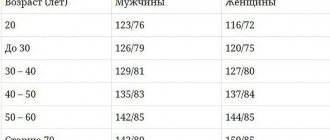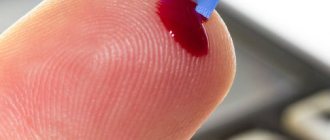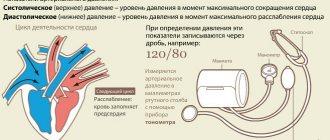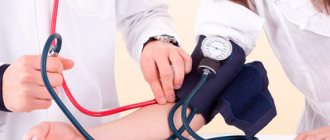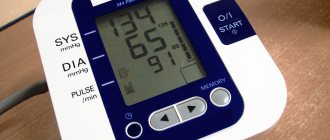- February 16, 2019
- Tests and diagnostics
- Natalia Egorenkova
Our grandmothers measured blood pressure using a gold ring on a thread, but today there is no need for such creative manipulations. You can buy an electronic or mechanical tonometer at any pharmacy, and if you ask the pharmacist on which arm blood pressure is measured, you will most likely be told that on either arm. At home, a person begins to experiment, measures on his left and right hands alternately and is surprised to discover a significant difference in the indicators. What is the reason? Is the tonometer lying or is this normal? Let's figure it out and start with the main thing: why measure blood pressure at all?
The importance of blood pressure control
Please note: no matter what complaint a person comes to the therapist with, the doctor first measures the patient’s blood pressure. And there are reasons for this. Arterial, or in the language of doctors, blood pressure is the most important indicator of the state of the cardiovascular system, which is closely related to other vital functions of the body.
For example, a patient with persistently high blood pressure and severe swelling will definitely be referred to a nephrologist to check his kidneys. And of course, every diabetic knows that high blood pressure can raise blood sugar. That is, disturbances in the functioning of blood vessels and the heart are directly related to the activity of the endocrine system.
Some dangerous diseases are asymptomatic in the initial stage, so regular measurement of blood pressure at home will be the best marker for their timely detection. Moreover, this is equally important for people of any age. Now you need to figure out which blood pressure monitor is best to purchase.
How to measure blood pressure on your arm
When measuring blood pressure, the patient should not lean on anything with his hands. The hand on which the measurement is taken should lie quietly, but not hang. You should not sit with one leg crossed over the other, as this position will compress large vessels, which will most likely lead to a distorted result.
To measure blood pressure, it is recommended to take a comfortable position while sitting (lean back, relaxing your muscles) or lying down. The hand on which the measurement is taken should be placed approximately at chest level. If the arm is below the chest, the reading may be falsely low.
The cuff is installed approximately 2 cm above the elbow. Then it is tightened evenly so that it covers the upper limb with its entire surface. Since the thickness of the arm varies from place to place, the cuff should be tightened slightly at an angle.
If the measurement is carried out incorrectly and distorted results are obtained, a person may take the medicine on his own, which will lead to unpredictable consequences.
If the cuff is not properly secured when measuring blood pressure, unreliable results may be obtained. If the cuff is overtightened and/or slowly inflated with air, a false increase in blood pressure is noted, and if the cuff is inflated with air insufficiently, a falsely reduced value is noted.
You should not wear the tonometer cuff over clothing, and you should also make sure that the rolled up sleeve of clothing over the cuff does not pinch the limb.
When measuring blood pressure, the cuff should not be worn over clothing.
The instrument needle must be exactly at zero before starting the measurement. After this, air is quickly pumped in until the needle reaches the mark, which is approximately 20 mm Hg. Art. exceeds the level of systolic (upper) pressure (i.e. a little longer after the pulse disappears). Then the pressure in the cuff is gradually reduced. The division at which the first tone was heard corresponds to the systolic pressure, the last tone corresponds to the diastolic (lower) pressure of the patient.
If the tones are difficult to hear, the patient is advised to raise his arm up, then bend and straighten it several times.
Even in the absence of diseases accompanied by an increase or decrease in blood pressure, people over 40 years of age and patients at risk are recommended to measure it regularly.
What types of tonometers are there?
Many people remember how patients used to measure blood pressure in clinics using a hand-held device with a glass mercury scale. Such tonometers are called mechanical, and they are still relevant, but in modern models toxic mercury has been replaced with safe metal membranes.
These devices are the most accurate, therefore they are used by emergency doctors and employees of medical institutions. However, they can also be bought at the pharmacy, and a little later we will tell you how to measure blood pressure with a mechanical tonometer, but now we will consider the options for modern electronic devices:
- automatic and semi-automatic machines;
- wrist tonometer;
- finger tonometer;
- smart bracelet.
We will not consider a finger blood pressure monitor. This is an original device, but you shouldn't trust it. As cardiologists say, the farther from the heart you measure pressure, the greater the error the device will give.
Wrist tonometers are more accurate and also compact, but are not suitable for overweight people due to the limited length of the bracelet (only 21 cm), and are also not recommended for the elderly. Due to the loss of vascular elasticity in advanced age, the readings will be inaccurate.
Therefore, it is better to choose between mechanical and electronic devices, and young people leading an active lifestyle can buy a smart bracelet that measures blood pressure.
Mechanical tonometer
A manual apparatus for measuring blood pressure consists of a shoulder cuff with a pneumatic chamber, a hand pump with a check valve (rubber bulb), a stethoscope and a pressure gauge. Its error is only ±2 mmHg. Art., but in order to use the device, you need certain skills.
The algorithm for measuring pressure with a mechanical tonometer is as follows:
- the cuff is placed on the forearm, and on which arm it is better to measure blood pressure, we will tell you a little later;
- the bulb valve is checked, it should be closed;
- the attachments at the ends of the stethoscope (olives) are inserted into the ears, the head is applied to the pulsating point on the elbow;
- using a bulb, the air is pumped to 170-200, after which the valve valve is smoothly unscrewed;
- the first pulse of blood (the sound of the pulse) will indicate the upper (systolic) pressure on the manometer;
- at the moment you stop listening to pulse sounds, the lower (diastolic) indicator is recorded.
When measuring blood pressure with a handheld blood pressure monitor, you need to listen and watch at the same time, which can be difficult for an older person. It makes sense to buy a mechanical device if there is someone nearby who can measure the pressure of another, like a doctor to a patient in a clinic. Otherwise, you should give preference to electronic models.
What else affects the correctness of the results?
Mechanical tonometers are recognized as the most reliable devices for measuring blood pressure. However, using the devices requires certain skills. The task becomes more difficult if the patient feels unwell.
Measuring blood pressure with an automatic tonometer is an incredibly simple procedure. All you need to do is secure the cuff correctly, take the correct position, and press the start button. However, even the best machines do not always accurately measure blood pressure. Therefore, it is advisable to periodically compare the performance of automatic and mechanical devices.
In addition, you should familiarize yourself with and follow other measurement rules:
- Calm down. During times of stress and anxiety, blood pressure increases due to physiological reasons. If you measure your blood pressure while you are excited, your readings are guaranteed to be too high. It is advisable to sit in a chair for a few minutes before taking measurements, leaning on its back and relaxing.
- Rule 30 minutes. Half an hour before the measurement, you should not smoke, drink alcohol, or drink caffeine-containing drinks (coffee, tea, Coca-Cola, energy drinks). They increase blood pressure, so you will get inflated results. After physical activity, measurements are also taken no earlier than half an hour later.
- Restriction of food. One hour before the measurement, you must avoid eating.
- Preparation. The cuff is attached to the arm so that its lower edge is 2 cm above the bend of the elbow, and the center is in the middle of the chest level. The arm with the cuff should lie on the table, the back rests on the back of the chair, and the legs are on the floor.
- During the measurement, you cannot talk, cross your legs, or hold your breath.
- Choose the correct cuff size. It should cover at least 80% of the shoulder. Large people are recommended to buy devices with an extended cuff. On the contrary, very thin people need to pay attention when purchasing what arm circumference is the minimum acceptable.
Semi-automatic blood pressure monitor
A modern semi-automatic machine is also equipped with a cuff and a hand pump, but a pressure gauge and a stethoscope, and therefore the eyes and ears, are replaced by an electronic unit - a pulse converter. The device is also equipped with a large display that displays the information received. The instrument error is about 3 mm Hg. Art., and even a visually impaired and hard of hearing person can cope with it. Such devices operate on batteries.
Let's look at how to correctly measure blood pressure with a semi-automatic electronic tonometer:
- the cuff is placed on the arm;
- The device is turned on with the Start button;
- the electronic unit checks the functionality of the device and signals its readiness with an audible signal;
- a hand pump pumps air until the next sound signal, usually this occurs at a value of about 200 mm Hg. Art.;
- Now all that remains is to deflate the air using the button located next to the bulb.
The device will do the rest itself and display the measurement results on the display. In people suffering from atrial fibrillation, semi-automatic blood pressure monitors sometimes pause the measurement process, which is displayed on the display. Repeatedly pumping air into the cuff may inflate the final readings, so it is better to repeat the process all over again.
As practice shows, semi-automatic devices are quite easy to use, reliable and durable. They also measure your pulse and remember the readings. The only negative is the independent injection of air, which means muscle work, which can, albeit slightly, distort the results.
This is why people are much more willing to purchase more advanced machines.
We measure pressure correctly
To correctly measure blood pressure, you need:
- take a sitting position;
- put the cuff on the hand or shoulder;
- if the device is automatic, press the “start” button; if mechanical, start quickly pumping air into the cuff, then slowly release it;
- re-measure if necessary;
- record your testimony in your diary.
Pressure cannot be measured in a standing position, as it affects the result.
Factors distorting blood pressure values
Various factors influence the measurement results. In first place are smoking, alcohol and caffeine. On average, they increase the SBP value by 10 mmHg. Art. and DBP - by 8 mm Hg. Art. That is why it is recommended to give up cigarettes and coffee two hours before the procedure. Alcohol is completely prohibited for people whose health condition requires constant monitoring of blood pressure.
Incorrect body position also leads to distorted results. If the arm is without support, the readings increase by 7 mm Hg. Art. In cases where the back is left without support, jumps of up to 8 mm Hg are observed. Art.
The highest deviation from the actual figures causes fullness of the intestines and bladder. In some cases the difference reaches 27 mmHg. Art. Rarely seen.
Which device is better to choose?
Modern studies have shown that the most accurate figures are obtained by measuring blood pressure using a mechanical tonometer. However, its use at home requires the help of outsiders. For this reason, people prefer electronic models.
The main difficulty is choosing between devices with a cuff on the shoulder and wrist. Tonometers of the second type show a lower percentage of accurate measurements, since they react to any movement, but they have their advantages:
- convenient to use during working hours;
- do not squeeze the hand;
- easy to use;
- compact.
The choice of tonometer depends on individual characteristics and needs. Your doctor will help you choose the most suitable model.
The size of the cuff of the device should correspond to the circumference of the shoulder or hand. Excessive compression provokes an increase in blood pressure.
How to properly fasten the cuff
If the tonometer is equipped with a brachial cuff, it is secured above the location of the brachial artery. The lower edge is fixed 2-3 cm above the elbow. It is customary to leave a distance equal to the width of one or two fingers between the fabric and the skin. The level of the cuff should coincide with the level of the heart.
If a wrist tonometer is used, ensure that the cuff fits snugly to the arm. The device is placed at a distance of 1 cm from the palm. It is recommended to attach the display to the inside of the hand, since in this position it is convenient to look at it.
The technique for using a specific tonometer model is described in the instructions for the device.
Is it possible to measure blood pressure frequently?
To obtain a complete picture of blood pressure fluctuations, readings are taken over 7-8 days. Doctors recommend taking the first measurement in the morning and the second one an hour after dinner.
To avoid distortion of the results, you need to take several measurements in a row.
The obtained figures are entered into a special diary to give the doctor the opportunity to track blood pressure fluctuations without prescribing daily monitoring.
Automatic blood pressure monitor
How to correctly measure blood pressure with an automatic tonometer can be explained even to a child, who will help his grandmother or grandfather cope with this work. These devices no longer have a bulb, but only an electronic unit and a cuff remain, which they fix on the arm, press the Start button and wait for the result. However, the error of such devices is 5 mm art. Art.
Most models of automatic tonometers, in addition to being powered by batteries, are equipped with mains adapters, which allows you to save on consumables. However, it still doesn’t hurt to have a set of batteries if, for example, a person lives in a country house where the electricity is periodically cut off.
There are other additional options that may interest you.
Possibilities of electronic tonometers
Modern automatic devices for measuring blood pressure can have advanced functionality, for example:
- arrhythmia indicator (heart-shaped icon);
- determining the average of the last three measurements;
- energy saving mode;
- clock and calendar;
- voice notification of results;
- possibility of using up to 5 different cuffs (models for professional healthcare workers).
Among these options, the most important is the arrhythmia indicator, which allows you to identify severe heart pathologies. Now we need to consider whether the accuracy of blood pressure measurement depends on the size of the cuff.
Correct fixation of the measuring device
Applying the cuff depending on the arm
When measuring blood pressure, it is very important to correctly fix the tonometer cuff, since the accuracy of the measurements . If you fix the cuff poorly, then there is a very small chance of getting correct results.
It is necessary to fix the cuff at a level of 2 cm above the elbow cavity. It is very important to tighten it evenly so that the entire surface of the cuff is clearly fixed on the arm.
Due to the fact that the thickness of the arm is not the same in different places , the cuff must be tightened slightly obliquely . If you tighten the cuff evenly, you may get inaccurate readings from the device .
Tonometer cuff
If the cuff does not fit, the large one will dangle on the forearm, and the small one will begin to tighten too much. In both cases, the result of measuring blood pressure will be biased, so you should take the choice of a blood pressure cuff seriously.
Since mechanical devices are more often used by medical staff, the devices are equipped with a wide variety of cuffs: for newborns, children, a hip version, etc. However, for home use, you should choose a standard cuff with a pneumatic chamber length of 25-40 cm.
For electronic tonometers, you can choose a cuff of the following sizes:
- for children (15-22 cm);
- medium (22-32 cm);
- universal (22-42 cm);
- large for overweight people (32-42 cm).
It is most convenient to buy a tonometer with a universal cuff, but doctors still advise choosing the size according to the build of the person who will use the device more often than other family members.
Now let’s move on to the question that worries many: on which arm is blood pressure measured?
A number of basic mistakes when measuring pressure
It doesn’t matter which hand you use to measure pressure with an electronic tonometer, if the procedure itself is carried out with some errors, the readings on the tonometer may turn out to be unreliable. The most common factors include the following:
- If the patient sits tense and has nothing to lean on, the readings will be higher.
- Also, the indicators will be overestimated when the hand is below the level of the heart when measuring. Otherwise, when the hand is higher than the heart, the readings on the tonometer will be lower.
- If you measure your blood pressure immediately after physical activity, the results will certainly be overestimated.
- Also, the pressure will be reflected in an inflated direction if the cuff is tightly tightened.
- It is also important that the results can be reflected during normal movements during the procedure. This also applies to normal conversation.
- Before each measurement procedure, the device must be calibrated.
- In addition to overestimated results, the device can also show underestimated results. This can happen if there is insufficient pumping.
- The actual pressure can also change with uneven pumping. If you do this very slowly, the diastolic pressure tends to be too high. In the case of rapid pumping, the diastolic value also increases, but the systolic value begins to decrease.
Right or left?
As mentioned above: the closer to the heart the pressure is measured, the more accurate the result will be. Therefore, healthy people without a diagnosis of hypertension or hypotension are recommended to monitor the pressure on the left arm. If it’s so inconvenient for left-handed people, you can use the right one.
For hypertensive and hypotensive patients, different rules apply. It is necessary to take measurements on both hands, preferably 3 times with an interval of 3 minutes. The indicators are recorded, compared, and if the values on one of the hands are consistently higher, from then on the pressure is measured on this hand.
What does the difference in indicators mean?
The ideal blood pressure for men and women over 17 years of age is considered to be 120/80. If the measurement results are persistently below normal, the patient is diagnosed with hypotension, and if the measurement results are consistently high, the patient is diagnosed with hypertension. For many men and women over 50 years of age, upper blood pressure often exceeds 140 mm Hg. Art. This is not the norm and indicates the development of vascular and heart diseases.
Also, the difference in indicators on the left and right arm may indicate a pathology of the venous system or a cerebrovascular accident (pre-stroke condition). If it is 15-20 mmHg. Art., you need to seek medical help.
A small difference of 5-10 units should not be a cause for concern. However, when working with a tonometer, it is important not only on which arm the blood pressure is measured, but how correctly the procedure is performed and whether there are any factors that provoke an increase in readings.
What does blood pressure depend on?
The level of pressure in a person varies depending on age, time of day (increases slightly in the evening), physical activity before measurement (increases after a shower, walking, jogging), the presence of bad habits (smokers and people who abuse alcohol have higher blood pressure) , consumption of a number of foods and drinks (BP increases by salty, fatty, fried, sweet foods, caffeine-containing drinks, etc.). In addition, blood pressure is slightly different in women and men (by 5-10 mm Hg).
At 20-40 years old, blood pressure is considered normal: 120/80 mm Hg. Art., a deviation of 10 mm Hg is permissible. Art. down or up.
Why does blood pressure rise?
Imagine the situation: a person is on edge, nervous, has a headache, and he decides to measure his blood pressure. The high rate terrifies him, and an ambulance is used: pills to lower blood pressure, for example Corinfar. Unable to calm down, 10 minutes later he measures again, the readings are the same, and in a panic he takes another pill. Any therapist will tell you that a sharp drop in blood pressure in a person with a weak cardiovascular system can lead to a stroke.
Therefore, it is necessary to remember that a short-term increase in pressure occurs in a stressful situation, after physical activity, strong coffee or smoking a cigarette. In the memo on how to measure blood pressure, among the recommendations it is stated that this should be done after the morning toilet, because if the intestines or bladder are full, the results will also be biasedly inflated.
